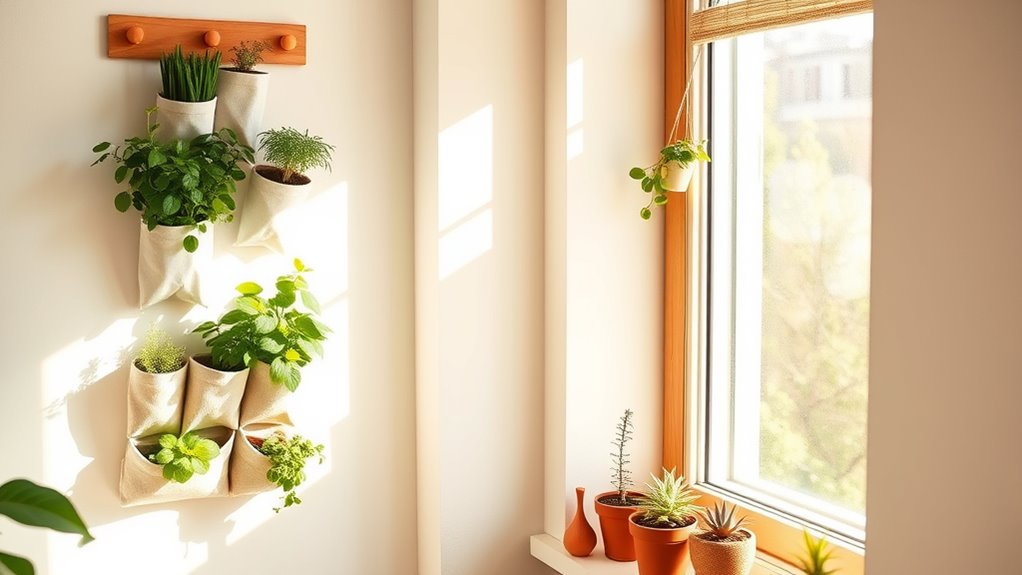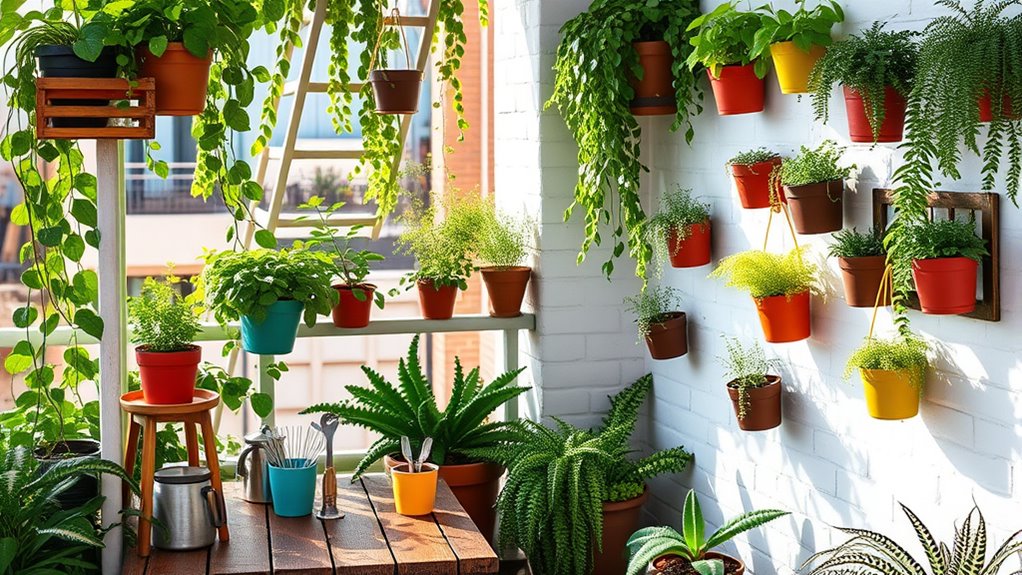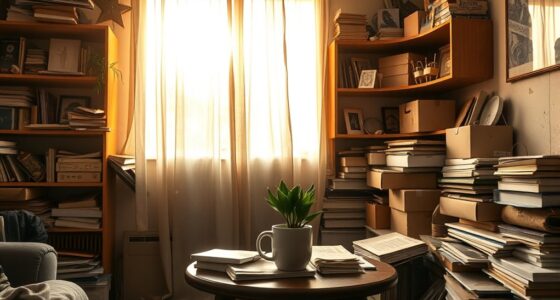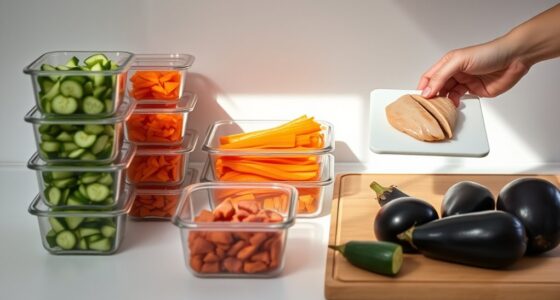To maximize your tiny apartment’s space, use vertical gardens with hanging planters and tiered shelves. Incorporate compact grow lights to extend growing seasons, and rotate crops seasonally to keep your plants healthy. Choose versatile containers and stacking setups to fit more greenery. Regular pruning and good air circulation prevent pests, while natural remedies like neem oil help keep pests away. Keep exploring for more clever hacks to turn your small space into a lush oasis.
Key Takeaways
- Use vertical gardening with wall-mounted planters and hanging baskets to maximize limited space.
- Incorporate tiered plant stands and stacking containers for multi-level growth.
- Opt for compact, container-friendly plants like herbs, microgreens, and small flowering varieties.
- Utilize adjustable grow lights to extend growing seasons and improve plant health indoors.
- Regularly prune and rotate plants to maintain a vibrant, pest-free indoor garden.

Living in a tiny apartment doesn’t mean you have to give up on having a lush, green space. With the right strategies, you can create a thriving indoor garden that brings freshness and vibrancy into your small space. One of the first steps is to focus on indoor pest control. Pests like aphids, spider mites, and fungus gnats can quickly ruin your plants if left unchecked. To keep them at bay, inspect your plants regularly and use natural remedies such as neem oil or insecticidal soap. Keep your plants healthy by avoiding overwatering, which can attract pests, and ensure good air circulation by spacing plants appropriately. Introducing companion planting—placing certain plants together—can also deter pests naturally, creating a balanced ecosystem inside your apartment.
Create a lush indoor garden with natural pest control and strategic plant placement.
When it comes to seasonal planting, you’ll want to adapt your garden to the changing months. In small spaces, container gardening is your best friend. Use versatile pots that fit your space, and consider stacking or vertical gardening to maximize your planting area. During spring, try herbs like basil, cilantro, and parsley, which are easy to grow indoors and add flavor to your meals. Summer calls for vibrant flowering plants like marigolds or petunias that can brighten your living room or balcony. In fall, focus on hardy greens such as kale or lettuce, which thrive in cooler temperatures. Winter might seem limiting, but you can still grow root vegetables like radishes or even sprout microgreens on a sunny windowsill. Planning your seasonal planting ahead of time ensures you have a continuous supply of fresh herbs and greens throughout the year.
To make the most of your tiny apartment, consider using tiered plant stands or hanging planters to free up floor space. Compact grow lights can extend your growing season and improve plant health by providing adequate light, especially during darker months. Regular pruning and cleaning help prevent pests and encourage healthy growth. Also, rotate your crops seasonally—what works in spring might need replacing or repositioning in winter. A key aspect of maintaining healthy plants is understanding second trimester overview, as it highlights the importance of regular check-ups and monitoring development, which can be translated to keeping your garden in top condition. Don’t forget, maintaining a clean environment with good indoor pest control practices will keep pests away and your plants thriving. Keep the area free of fallen leaves or debris, which can attract unwanted insects.
In short, smart indoor pest control combined with thoughtful seasonal planting can turn even the smallest apartment into a lush oasis. With some planning and regular upkeep, you’ll enjoy fresh herbs, colorful flowers, and the calming presence of your indoor garden year-round. Your tiny space can become an abundant, vibrant retreat that feeds both your soul and your stomach.
Frequently Asked Questions
How Can I Maximize Sunlight in a Shaded Apartment?
If your apartment is shaded, you can maximize natural light by placing reflective surfaces like mirrors or white walls opposite windows. These surfaces bounce sunlight around, making the space feel brighter and more open. Keep window treatments light and minimal to let in as much natural light as possible. Also, consider using light-colored or translucent plant containers to reflect sunlight onto your plants, helping them thrive even in shaded spots.
What Are the Best Pest Control Methods for Small Indoor Gardens?
Think of your small garden as a peaceful kingdom needing protection. You can guard it with natural repellents like neem oil or garlic spray, acting as vigilant knights. Companion planting works like friendly neighbors, deterring pests by creating an unwelcoming environment. Regularly inspect your plants and keep your garden clean, ensuring pests don’t overrun your tiny sanctuary. These methods keep your garden healthy and thriving, free from harmful invaders.
How Often Should I Water My Tiny Potted Plants?
Your watering schedule is key to maintaining healthy plant hydration. Typically, you should water your tiny potted plants when the top inch of soil feels dry. This usually means watering once every few days, but it varies based on the plant type and indoor conditions. Always check soil moisture first, and avoid overwatering to prevent root rot. Adjust your watering routine as needed to keep your plants thriving.
Can I Grow Vegetables Indoors Year-Round?
Ever wondered if you can grow vegetables indoors year-round? The answer is yes, but it depends on your understanding of composting techniques and plant nutrient requirements. You’ll need to supply consistent light, manage humidity, and monitor nutrient levels carefully. With the right setup, your tiny apartment can become a lush, productive garden—turning even the smallest space into a year-round vegetable haven.
What Are Space-Saving Storage Options for Gardening Tools?
For space-saving storage options for gardening tools, consider using vertical shelving to maximize wall space and keep tools organized and accessible. Multi-functional containers are also great—they can store small tools, seeds, and accessories while saving space. You can hang hooks on shelves for tools like trowels and pruners. These solutions help you keep your tiny apartment neat and your gardening essentials within easy reach.
Conclusion
Even in the smallest spaces, your garden can flourish, proving that size doesn’t limit growth. While your apartment may be compact, your green sanctuary is vast with creativity and care. Think of your tiny apartment as a canvas—each plant a stroke of life, each hack a brushstroke of innovation. Embrace the challenge, and watch how your small space transforms into a lush oasis, where the tiniest details make the biggest impact.









